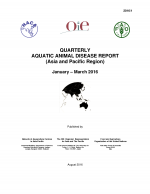Reported Aquatic Animal Diseases in the Asia-Pacific Region during the Second Quarter of 2023
30 October 2023 | 779 views | Freshwater finfish, Health and welfare, Marine finfish, Molluscs (shellfish and other), Shrimp, Australia, Bangladesh, India, Philippines, Thailand
With the implementation of the new aquatic animal disease reporting in the Asia Pacific region from January 2021, and in lieu of the published QAAD Reports (last issue published was 4th quarter of 2020), NACA is publishing reported aquatic animal diseases submitted by countries in the Asia-Pacific region. This report covers the second quarter of 2023 and the original and updated reports can be accessed from the QAAD page. The following diseases were reported:
Finfish diseases
- Infection with Aphanomyces invadans (EUS): Bangladesh in catla (Catla catla) and mrigal (Cirrhinus mrigala); and, India in climbing perch (Anabas testudineus) and snakehead (Channa marulius).
- Infection with epizootic haematopoietic necrosis virus: Australia in adult redfin perch (Perca fluviatilis)
- Infection with red seabream iridovirus (RSIV): Chinese Taipei in hybrid grouper (Epinephelus fuscoguttatus x E. lanceolatus); and, India (ISKNV) in oscar (Astronotus ocellatus) and black tetra (Gymnocorymbus ternetzi)
- Infection with Tilapia lake virus (TiLV): India in tilapia (Oreochromis niloticus), and Philippines in tilapia fry (Oreochromis sp.).
- Grouper iridoviral disease (GIV): Chinese Taipei in seabass (Lates calcarifer)
- Viral encephalopathy and retinopathy (VER): Chinese Taipei in hybrid grouper (Epinephelus fuscoguttatus x E. lanceolatus), seabass (L. calcarifer) and giant grouper (E. lanceolatus).
Molluscan diseases
- Infection with Perkinsus olseni: India in farmed mussel (Perna viridis), and wild samples of charru mussel (Mytella strigata) and black clam (Villorita cyprinoides).
Crustacean diseases
- Infection with white spot syndrome virus (WSSV): Australia in farmed black tiger shrimp (Penaeus monodon); Bangladesh in black tiger shrimp (P. monodon); Chinese Taipei in whiteleg shrimp (P. vannamei); India in P. monodon and P. vannamei; and, the Philippines in P. vannamei (PL, juveniles, grow-out culture, and adult), P. monodon (PL, grow-out culture, broodstock), freshwater prawn broodstock (Macrobrachioum rosenbergii), and crab (adult).
- Infection with infectious hypodermal and haematopoietic necrosis virus (IHHNV): India in P. monodon; the Philippines in P. vannamei (PL and grow out culture) and P. monodon (grow-out culture); and, Thailand (marine shrimp, species not specified).
- Acute hepatopancreatic necrosis disease (AHPND): Bangladesh in P. monodon; Chinese Taipei in P. vannamei; the Philippines in P. vannamei (grow-out culture and adult) and P. monodon (eggs, PL, juveniles) and P. indicus (grow out culture); and Thailand (marine shrimps, species not specified).
- Infection with Infectious myonecrosis virus (IMNV): India in P. vannamei.
- Infection with decapod iridescent virus 1 (DIV 1): Chinese Taipei in P. vannamei.
- Hepatopancreatic microsporidiosis caused by Enterocytozoon hepatopenaei (EHP): India in P. vannamei; the Philippines in P. vannamei (PL and grow out culture) and P. monodon (PL); and, Thailand (marine shrimps, species not specified).
Amphibian diseases
- Infection with Ranavirus species: Chinese Taipei in bullfrog (Lithobates catesbeianus).
- Infection with Batrachochytrium dendrobatidis: Australia in unknown species of frog.
Other diseases
- Bangladesh reported Infection with Streptococcus agalactiae in Tilapia (O. niloticus), and Infection with Aeromonas spp. in shing catfish (Heteropneustes fossilis), gulsha (Mystus cavasius) and pangas catfish (Pangasianodon hypophthalmus).
E.M. Leaño
Senior Programme Officer
Health and Biosecurity
Creative Commons Attribution.
